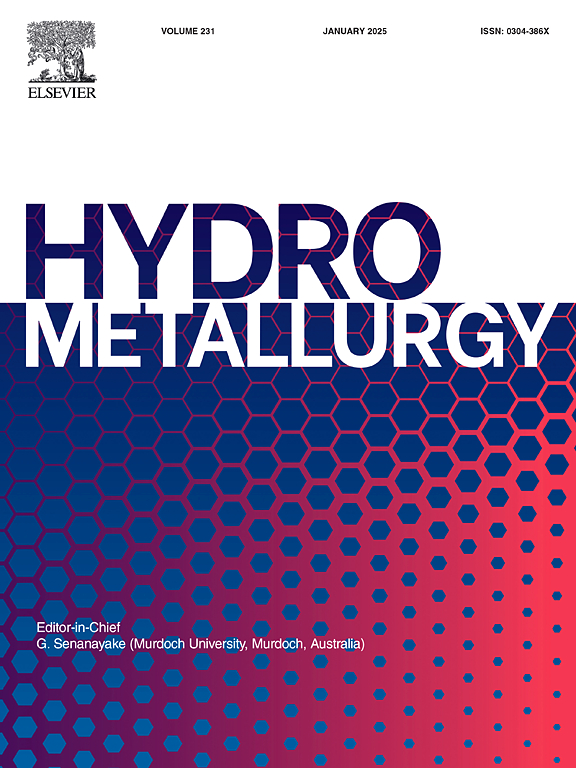Evaluating the effectiveness of iron oxide (Fe3O4) nanoparticles vs. traditional chloride methods for copper cementation and recovery from industrial waste solutions by aluminium
IF 4.8
2区 材料科学
Q1 METALLURGY & METALLURGICAL ENGINEERING
引用次数: 0
Abstract
The cementation of copper on aluminium is a well-studied process, typically facilitated by chloride ions to overcome the insulating aluminium oxide layer. This study presents an alternative approach using magnetite (Fe₃O₄) nanoparticles as electron (redox) mediators, allowing the cementation process to occur despite the presence of the aluminium oxide layer. After optimizing the concentration of the Fe₃O₄ suspension, the pH, and the reaction time, the performance of this method was compared to the classical chloride ion-based approach. The nanoparticle assisted method achieved higher recovery (%) of copper, but at a slower pace. This difference in reaction speed explains the more compact, non-oxidize copper deposits observed by SEM and DRX, in contrast to the dendritic and airy deposits with a high fraction of Cu₂O obtained using the classical chloride method. Under optimized conditions, the method was applied for the recovery of Cu from two industrial PCB solutions, achieving excellent recoveries after adjusting the pH.

评价氧化铁(Fe3O4)纳米颗粒与传统氯化物方法在铜胶结和铝回收工业废液中的有效性
铜在铝上的胶结是一个很好的研究过程,通常由氯离子来克服绝缘氧化铝层。这项研究提出了一种替代方法,使用磁铁矿(Fe₃O₄)纳米颗粒作为电子(氧化还原)介质,允许在存在氧化铝层的情况下发生胶结过程。通过优化Fe₃O₄悬浮液的浓度、pH和反应时间,将该方法的性能与经典的氯离子法进行了比较。纳米颗粒辅助方法获得了更高的铜回收率(%),但速度较慢。这种反应速度的差异解释了SEM和DRX观察到的更致密,非氧化的铜矿床,而不是用经典的氯化物方法获得的含有高分数Cu₂O的枝状和airy矿床。在优化的条件下,将该方法应用于两种工业PCB溶液中Cu的回收,调整pH后,回收率均达到了优异的水平。
本文章由计算机程序翻译,如有差异,请以英文原文为准。
求助全文
约1分钟内获得全文
求助全文
来源期刊

Hydrometallurgy
工程技术-冶金工程
CiteScore
9.50
自引率
6.40%
发文量
144
审稿时长
3.4 months
期刊介绍:
Hydrometallurgy aims to compile studies on novel processes, process design, chemistry, modelling, control, economics and interfaces between unit operations, and to provide a forum for discussions on case histories and operational difficulties.
Topics covered include: leaching of metal values by chemical reagents or bacterial action at ambient or elevated pressures and temperatures; separation of solids from leach liquors; removal of impurities and recovery of metal values by precipitation, ion exchange, solvent extraction, gaseous reduction, cementation, electro-winning and electro-refining; pre-treatment of ores by roasting or chemical treatments such as halogenation or reduction; recycling of reagents and treatment of effluents.
 求助内容:
求助内容: 应助结果提醒方式:
应助结果提醒方式:


